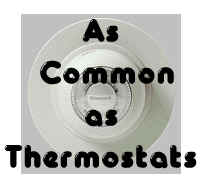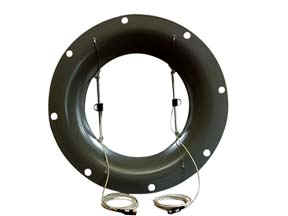
AutomatedBuildings.com
|
[an error occurred while processing this directive] |

Len Damiano
Contributing Editor
Once upon a time…there was a simple way to supply conditioned air and ventilation intake air to large buildings. Designers provided "large" systems that were set up once, they ran almost continuously thereafter and where controlled primarily on space temperature requirements. No problem….until the underlying economic or environmental conditions change.
Our story began with the growing popularity of Variable Air Volume (VAV) system designs in the mid 1970's. Prior to that, fossil fuels were cheap and building envelopes were leaky. After the Oil Embargo in 1974, buildings became much tighter and VAV became more popular. VAV system designs generally offered much more energy efficiency than the constant volume (on/off) designs previously the standard in larger buildings.
[an error occurred while processing this directive]With this change in design philosophy came consequential changes in building controls and to the instrumentation used. More dynamic methods of temperature control created the need to provide more dynamic ways to control building pressurization and some way to maintain required outside air intake rates.
As was the case with volumetric fan tracking control for VAV systems, measurement technology lagged need. Pitot arrays were sold as the answer to building pressurization control and the means to provide indirect control of ventilation. Unfortunately, the ability of the velocity pressure-based product to perform reliably was oversold to optimistic engineers and owners. As-built designs appeared to ignore the placement limitations recommended by the manufacturers. The installed performance of many of these devices was so poor that it caused major problems for building operators. So much so, that they were eventually disconnected or removed. Many of the problems experienced in the past can be attributed to the limitations of the technology or the installation circumstances forced onto them. These situations still occur today.
Technology usually lags need, as was the case with volumetric fan tracking control for VAV systems. Pitot arrays were sold as the answer to building pressurization control and the means to provide continuous ventilation rates. Unfortunately, the ability of the velocity pressure-based product to perform consistently was oversold to eager engineers and owners. Designs and/or contractors appeared to ignore the placement limitations recommended by the manufacturers. The installed performance of many of these devices was so poor that it caused major problems for building operators. So much so that they were eventually disconnected and/or removed. Many of the problems they experienced can be attributed to the limitations of the technology or the installation circumstances forced onto them. Most of these situations still occur today.
These problems left many engineers and owners with a generalized bad taste about all airflow measurement. Unfortunately, most engineers and building operators are not familiar enough with controls and control components to easily distinguish what is bad about a particular technology vs. what is bad about a particular product or system design.
So what can a diligent engineer or responsible owner do to insure that their building's air system is operating as intended, under as-built conditions, under all operating and environmental conditions, without the space for instrument placement normally needed? How can the air handling system be optimized for energy usage without a valid and reliable control input for outside air?
 A
new era in HVAC control has arrived with the
release of two new product lines, expected to revolutionize the use of airflow
control in commercial
ventilating systems. The devices manufactured by EBTRON provide a building's
controls with a level of functionality, accuracy and reliability never before
dreamed possible from a commercial airflow sensor.
A
new era in HVAC control has arrived with the
release of two new product lines, expected to revolutionize the use of airflow
control in commercial
ventilating systems. The devices manufactured by EBTRON provide a building's
controls with a level of functionality, accuracy and reliability never before
dreamed possible from a commercial airflow sensor.
Designed for the commercial and institutional building markets, these instruments provide precise airflow measurement inputs for use by a building's automated control system. Reliable and accurate measurements are required to optimize dilution ventilation rates for acceptable Indoor Air Quality in offices, hospitals, schools and laboratories. They are also required for the reliable control of space pressurization.
A large number of significant features are included in the new designs, many never before available to users of airflow control instrumentation:
The end results of the development process are scientific-grade, price-sensitive, commercial HVAC products that are easy to apply, specify, order and install; and that normally never requires cleaning, maintenance, field-calibration or adjustment.
Laboratory test data has convincingly proven that EBTRON’s thermal dispersion airflow measurement devices may be applied in closer proximity to duct fittings and accessories than any other air measurement technology. High sensor density, electronic airflow measurement systems are ideal for applications requiring accurate and repeatable airflow data, when no field adjustment is desired. Thermal dispersion technology can accurately determine airflow in traditionally difficult locations, since each sensor is independent and does not require a stable profile of total and static pressures.
The model GTA116-PC is well suited for the direct measurement of outdoor air flow rates, providing optimal dilution intake rate control and compliance with ASHRAE 62-1999 or any local ventilation code. Sensor probes can be located immediately upstream (as close as 3 in.) from open intake damper blades. A special standoff bracket option allows for the direct mounting of sensor probes to the intake damper frames, when there is no ductwork immediately upstream.
The GTA116-PC was developed with most of the "traditional" options included as standard. Each GTA116 transmitter serves a single duct location. It requires 24 VAC power, provides the host controls with linear output signals and is provided with field selectable outputs: an isolated 4-20 mA or 0-10 VDC for both airflow and temperature. The GTN116-PC offers a serial interface currently with digital communication protocols being field-selectable: Johnson Controls N2® or ModBus®. Future versions may expand those options to include FLN and BacNET MSTP. LonWorks compatible systems will also be available around the end of this year.
 "Smart" sensor technology imbeds the
calibration data of each sensor probe in the cable assembly, making the
transmitter fully independent
of the probes. Output scaling can be easily configured in the field. All
GTA116 and GTN116 transmitters include a standard 16-character LCD display,
which indicates both airflow and temperature. The display may also be used
during configuration and diagnostic modes. Field configuration uses a simple
four-button interface on the main circuit board. Individual airflow and
temperature measurements may be displayed from the diagnostic mode. In
addition, each transmitter is provided with several "digital
potentiometers" for airflow signal filtering (for transient wind effects)
and for output signal offset and gain adjustments. Because they can be enabled
only through internal software, there is no potential for the adjustment to
change accidentally or drift. There is also a reset capability that allows the
user to revert to the factory defaults and calibration at any time.
"Smart" sensor technology imbeds the
calibration data of each sensor probe in the cable assembly, making the
transmitter fully independent
of the probes. Output scaling can be easily configured in the field. All
GTA116 and GTN116 transmitters include a standard 16-character LCD display,
which indicates both airflow and temperature. The display may also be used
during configuration and diagnostic modes. Field configuration uses a simple
four-button interface on the main circuit board. Individual airflow and
temperature measurements may be displayed from the diagnostic mode. In
addition, each transmitter is provided with several "digital
potentiometers" for airflow signal filtering (for transient wind effects)
and for output signal offset and gain adjustments. Because they can be enabled
only through internal software, there is no potential for the adjustment to
change accidentally or drift. There is also a reset capability that allows the
user to revert to the factory defaults and calibration at any time.
Gold anodized sensor probes are available with three mounting options: duct insertion, internal to duct or plenums, and standoff from dampers, filters or coils. Insertion mounting probes are installed through one side of the duct. Probes greater than 18 inches will have a 1-1/2" mounting stud, which protrudes out of the opposite side of the duct. Internal mounting probes are designed to be installed from inside a duct or plenum and have +/- 3/4" adjustability from the customer-specified nominal duct size. Standoff mounting option for probes are intended to be installed upstream of intake dampers, directly to the damper frame or housing, so that the trailing edge of the probe is 3 inches upstream of the leading edge of the fully open damper blades. Each mounting option is provided with a standard 10 foot, U. L. plenum-rated (CL2P) cable to the remote transmitter using a small circular terminal connector.
You wouldn't attempt to control space temperature without permanently mounted thermostats, so, why would anyone try to control ventilation rates without permanently mounted airflow measuring devices? Dynamic systems require dynamic methods of control to be efficient. With all the tremendous number of new features and functionality available from EBTRON, combined with the shrinking costs of electronic components; airflow sensors may some day become as common as thermostats.
[an error occurred while processing this directive]
[Click Banner To Learn More]
[Home Page] [The Automator] [About] [Subscribe ] [Contact Us]